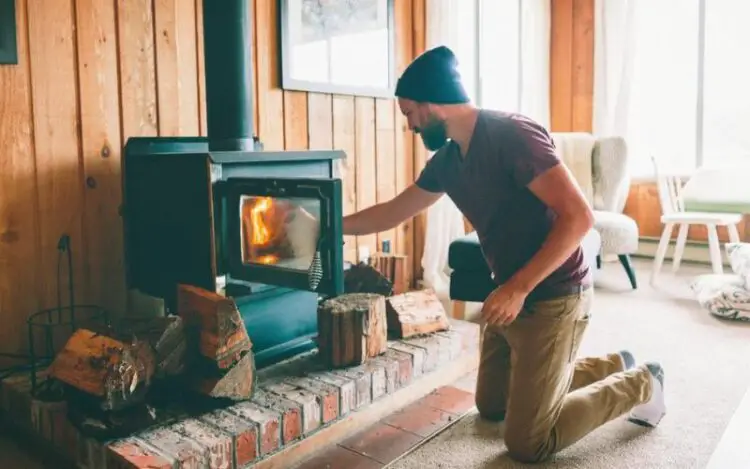There is nothing better than a hot summer night around a fire with family, loved ones, pets, and an ice-cold drink with much-needed quality time. However, I bet that you don’t want to spend much time taking care of the fire whenever it’s about to be put out.
How To Keep A Fire Going In A Fireplace (6 Effective Methods)
So rather than rip up old newspapers all the time and flip over the logs in the hope that it may start to work well, here are some ideas and tips on how to keep a fire going in a fireplace for hours.
-
Use Seasoned Firewood
If you smoke but don’t get burnt, it might be because of a lack of seasoned firewood. Not every firewood for a fireplace is ready. It’s overflowing with humidity when the wood is freshly cut. In the proper context, it usually takes six months to one year for the wood to dry enough for fuel. Smoking happens if the timber has too much inner or outside moisture.
If you’ve got access to some, use seasoned firewood. Try another method when only green wood is available. Put unlit wood on the grate sides. Place the grate with sawdust and a wax composite fire log, but never add it to the current wooden fire.
Your firewood could be seasoned, but outdoors it was too cold. To address this problem, put your firewood in the home before it is used, so you can warm the log up to room temperature when you are ready to burn it.
-
Open Your Damper
It may be that the damper is either unopened or partially open if you are lighting a fire and smoke starts pouring out into your home. The combustion byproducts can’t pass through the fireplace, as they should, without an open damper and an unblocked flute.
Open the fucker throughout. If it doesn’t open completely, fix it as necessary. If it appears there may be other obstacles that prevent it from functioning correctly, contact a fireplace sweep.
-
Warm The Chimney
If your chimney is located on an outside wall and you don’t start your fire, it could be because the chimney’s flue has a chilly air column. When this happens, warm air can no longer escape via the fireplace.
What you need is to “preheat” your chimney. This can be achieved in numerous ways, one of which is a hairdryer.
Use it for at least 10 seconds in the chimney flue to regulate the hot air. Traditional strategies include creating a journal torch, lighting it, holding it to the damping torch, careful to drop it before it is burned.
If you’re using a lighted newspaper, it can take more than 10 seconds with your hairdryer or more than one torch. In any case, your heated flue could make all the difference to start your fire.
-
Start The Fire Right
The fire must be created in a form that helps to build a long, successful fire from the very beginning to keep a fire burning in a fire.
The objective is to get the fire starting as soon as possible. Then it should spread efficiently and without any problems to the logs from the fire starter.
There are two basic techniques to build a fire in the fireplace. In any case, it will function well, although one has some additional advantages than the other. A fire can be built in a fireplace by:
- The conventional method.
- The top-down method.
-
Don’t Add Big Logs To Fire Too Quickly
If you construct flames in an open fireplace with the conventional way of placing logs on the top of the fire, make sure you don’t add the largest pieces of wood to the fire too early.
The bigger logs from the flame may be difficult to illuminate because of their size and surface area. To hold bigger logs more efficiently, the temperatures must be warm enough within the fireplace.
Adding larger logs to the fire as it heats up helps avoid the fire from being buried by logs too big and helps to keep a fire from coming out in your fireplace.
To address this question, you too may put the largest logs at the start of the fire with the top-down fire approach since it is underneath the fire startup. Thus it takes longer to catch fire.
If your wood fireplace continues to go out, either add smaller logs when creating a fire or try making a fire using the top-down approach, so you may utilize the biggest logs right from the outset.
-
Burn Hardwood
To sustain a fire longer and hotter in a fireplace, seek to burn hardwood logs instead of softwood.
Hardwoods are usually stronger than softwoods; thus, you will find that hardwood logs survive longer in a fire before they entirely burn out. As a result, hardwood logs typically provide greater heat and for a longer time.
The combustion of hardwood logs also helps minimize the creosote (soot) in your chimney over time. However, softwood usually has greater sapphire content, and if you solely burn softwood, your chimney may require more regular cleaning to ensure your fireplace works as effectively as it does.
However, it is preferred not to use hardwood but softwood, as softwoods generally catch the light and burn faster, which is crucial during early fire stages.
Conclusion (How To Keep A Fire Going In A Fireplace?)
If the harsh biting winter blows outside, nothing surpasses the warm crackling and bright wood fire in an interior fireplace. Hopefully, our tips on how to keep a fire going in a fireplace should be of help.

